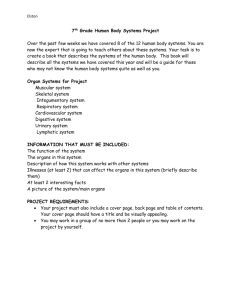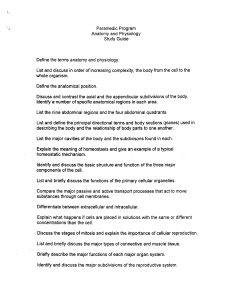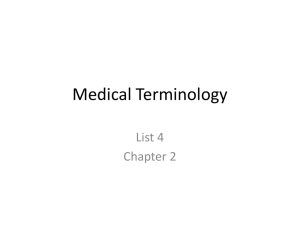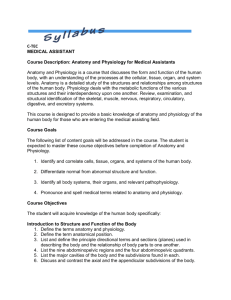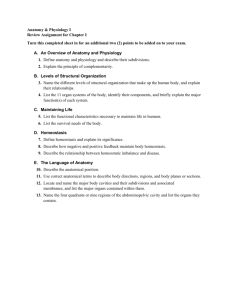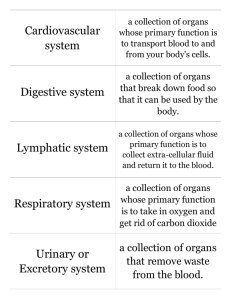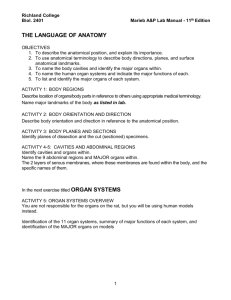College A & P syllabus - Rocori School District
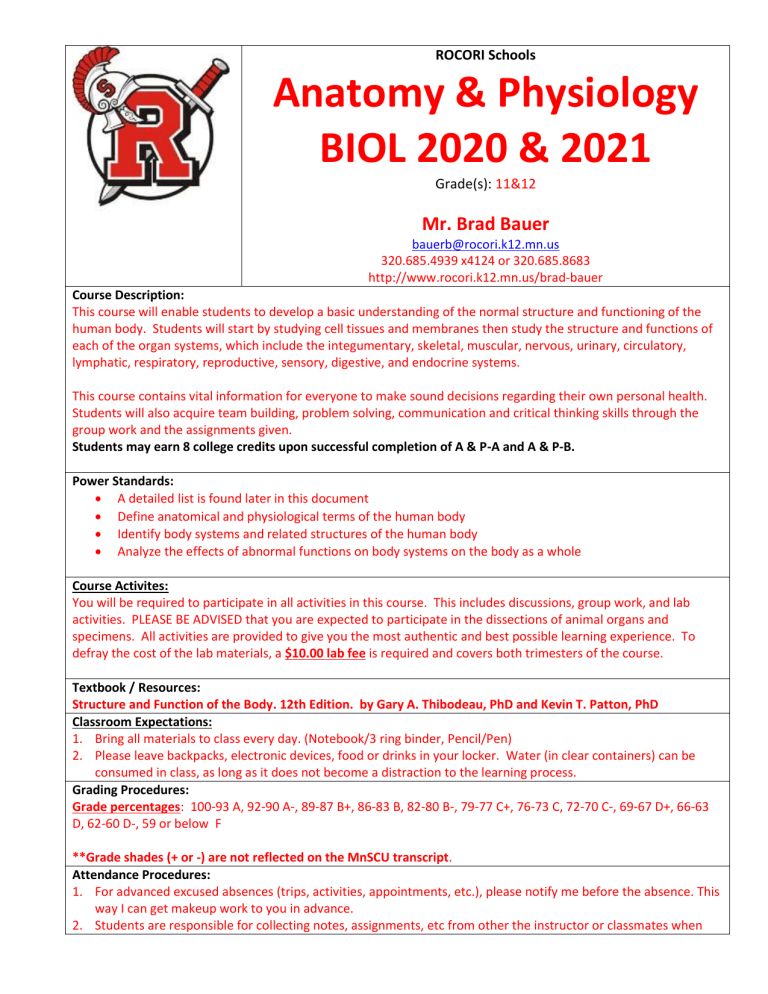
ROCORI Schools
Anatomy & Physiology
BIOL 2020 & 2021
Grade(s):
11&12
Mr. Brad Bauer
bauerb@rocori.k12.mn.us
320.685.4939 x4124 or 320.685.8683 http://www.rocori.k12.mn.us/brad-bauer
Course Description:
This course will enable students to develop a basic understanding of the normal structure and functioning of the human body. Students will start by studying cell tissues and membranes then study the structure and functions of each of the organ systems, which include the integumentary, skeletal, muscular, nervous, urinary, circulatory, lymphatic, respiratory, reproductive, sensory, digestive, and endocrine systems.
This course contains vital information for everyone to make sound decisions regarding their own personal health.
Students will also acquire team building, problem solving, communication and critical thinking skills through the group work and the assignments given.
Students may earn 8 college credits upon successful completion of A & P-A and A & P-B.
Power Standards:
A detailed list is found later in this document
Define anatomical and physiological terms of the human body
Identify body systems and related structures of the human body
Analyze the effects of abnormal functions on body systems on the body as a whole
Course Activites:
You will be required to participate in all activities in this course. This includes discussions, group work, and lab activities. PLEASE BE ADVISED that you are expected to participate in the dissections of animal organs and specimens. All activities are provided to give you the most authentic and best possible learning experience. To defray the cost of the lab materials, a $10.00 lab fee is required and covers both trimesters of the course.
Textbook / Resources:
Structure and Function of the Body. 12th Edition. by Gary A. Thibodeau, PhD and Kevin T. Patton, PhD
Classroom Expectations:
1.
Bring all materials to class every day. (Notebook/3 ring binder, Pencil/Pen)
2.
Please leave backpacks, electronic devices, food or drinks in your locker. Water (in clear containers) can be consumed in class, as long as it does not become a distraction to the learning process.
Grading Procedures:
Grade percentages: 100-93 A, 92-90 A-, 89-87 B+, 86-83 B, 82-80 B-, 79-77 C+, 76-73 C, 72-70 C-, 69-67 D+, 66-63
D, 62-60 D-, 59 or below F
**Grade shades (+ or -) are not reflected on the MnSCU transcript.
Attendance Procedures:
1.
For advanced excused absences (trips, activities, appointments, etc.), please notify me before the absence. This way I can get makeup work to you in advance.
2.
Students are responsible for collecting notes, assignments, etc from other the instructor or classmates when
they miss a day of class.
3.
Daily work must be handed in on time to receive full credit.
4.
Late assignments will receive no credit.
5.
Cheating will result in a zero for a test or assignment.
6.
Grades will be posted weekly by student I.D. numbers. Students are responsible for checking their progress.
Course Schedule
This course is completed over two trimesters (four terms). The following is an outline of the topics to be covered during each semester.
Anatomy & Physiology-A
Body as a Whole
Chapter 1: An Introduction to the Structure and Function of the Body
Define the terms anatomy and physiology.
List and discuss, in order of increasing complexity, the levels of organization of the body.
Define the anatomical position.
List and define the principal directional terms and sections (planes) used in describing the body and the relationship of body parts to one another.
List the nine abdominopelvic regions and the four abdominopelvic quadrants.
List the major cavities of the body and the subdivisions found in each.
Discuss and contrast the axial and appendicular subdivisions of the body. Identify a number of specific anatomical regions in each area.
Explain the meaning of the term homeostasis and give an example of a typical homeostatic mechanism.
Chapter 5: Integumentary System and Body Membranes
Classify, compare the structure of, and give examples of each type of body membrane.
Describe the structure and function of the epidermis and dermis.
List and briefly describe each accessory organ of the skin.
List and discuss the three primary functions of the integumentary system.
Classify burns and describe how to estimate the extent of a burn injury.
Framework of the Body
Chapter 6: Skeletal System
List and discuss the generalized functions of the skeleton.
Identify the major anatomical structures found in a typical long bone and discuss bone formation.
Discuss the microscopic structure of bone and cartilage, including the identification of specific cell types and structural features.
Explain how bones are formed, how they grow, and how they are remodeled.
Identify the two major subdivisions of the skeleton and list the bones found in each area.
List and compare the major types of joints found in the body and give an example of each.
Chapter 7: Muscular System
List, locate in the body, and compare the structure and function of the three major types of muscle tissue.
Discuss the microscopic structure of a skeletal muscle sarcomere and motor unit.
Discuss how a muscle is stimulated, and compare the major types of skeletal muscle contractions.
Name, identify on a model or diagram, and give the function of the major muscles of the body discussed in this chapter.
List and explain the most common types of movement produced by skeletal muscles.
Communication and Control
Chapter 8: Nervous System
List the organs and divisions of the nervous system and describe the generalized functions of the system as a whole.
List the major types of cells in the nervous system and discuss the function of each.
Identify the anatomical and functional components of the three-neuron reflex arc. Compare and contrast the propagation of an action potential along a nerve fiber and across a synaptic cleft.
Identify the major anatomical components of the brain and spinal cord and briefly comment on the function of each.
Compare and contrast spinal and cranial nerves.
Discuss the anatomical and functional characteristics of the two divisions of the autonomic nervous system.
Chapter 9: Sense Organs
Classify sense organs as special or general and explain the basic differences between the two groups.
Discuss how a stimulus is converted into a sensation.
Discuss the general sense organs and their functions.
Describe the structure of the eye and the functions of its components.
Discuss the anatomy of the ear and its sensory function in hearing and equilibrium.
Discuss the chemical receptors and their functions.
Chapter 10: Endocrine System
Distinguish between endocrine and exocrine glands and define the terms hormone and prostaglandin.
Identify and locate the primary endocrine glands and list the major hormones produced by each gland.
Describe the mechanisms of steroid and nonsteroid hormone action.
Explain how negative and positive feedback mechanisms regulate the secretion of endocrine hormones.
Identify the principal functions of each major endocrine hormone and describe the conditions that may result
from hyposecretion or hypersecretion.
Define diabetes insipidus, diabetes mellitus, gigantism, goiter, cretinism, and glycosuria.
Anatomy & Physiology-B
Transportation & Immunity
Chapter 11: Blood
Describe the primary function of blood.
Describe the characteristics of blood plasma.
List the formed elements of blood, and identify the most important function of each.
Discuss anemia in terms of red blood cell numbers and hemoglobin content.
Explain the steps involved in blood clotting.
Describe ABO and Rh blood typing.
Define the following medical terms associated with blood: hematocrit, leukocytosis, leukopenia, polycythemia, sickle cell, phagocytosis, acidosis, thrombosis, erythroblastosis fetalis, serum, fibrinogen, Rh factor, and anemia.
Chapter 12: Circulatory System
Discuss the location, size, and position of the heart in the thoracic cavity and identify the heart chambers, sounds, and valves.
Trace blood through the heart and co pare the functions of the heart chambers on the right and left sides.
List anatomical components of the heart conduction system and discuss the features of the normal
electrocardiogram.
Explain the relationship between blood vessel structure and function.
Trace the path of blood through the systemic, pulmonary, hepatic portal, and fetal circulations.
Identify and discuss the primary factors involved in the generation and regulation of blood pressure and explain the relationships among these factors.
Chapter 13: Lymphatic System and Immunity
Describe the generalized functions of the lymphatic system and list the primary lymphatic structures.
Define and compare nonspecific and specific immunity, inherited and acquired immunity, and active and passive immunity.
Discuss the major types of immune system molecules and indicate how both antibodies and complements
function.
Discuss and contrast the development and function of B cells and T cells.
Compare and contrast humoral and cell-mediated immunity.
Processing of Air, Food, and Wastes
Chapter 14: Respiratory System
Discuss the generalized functions of the respiratory system.
List the major organs of the respiratory system and describe the function of each.
Compare, contrast, and explain the mechanism responsible for the exchange of gases that occurs during internal and external respiration.
List and discuss the volumes of air exchanged during pulmonary ventilation.
Identify and discuss the mechanisms that regulate respiration.
Chapter 15: Digestive System
List in sequence each of the component parts or segments of the alimentary canal from the mouth to the anus
and identify the accessory organs of digestion.
List and describe the four layers of the wall of the alimentary canal. Compare the lining layer in the esophagus,
stomach, small intestine, pancreas and large intestine.
Discuss the basics of protein, fat, and carbohydrate digestion and give the end products of each of these processes.
Define and contrast mechanical and chemical digestion.
Define peristalsis, bolus, chyme, jaundice, ulcer, and diarrhea.
Chapter 17: Urinary System
Identify the major organs of the urinary system and give the generalized function of each..
Name the parts of a nephron and describe the role each component plays in the formation of urine.
Explain the importance of filtration, tubular reabsorption, and tubular secretion in urine formation.
Discuss the mechanisms that control urine volume.
Explain how the kidneys act as vital organs in maintaining homeostasis.
Cycle of Life
Chapter 20: Reproductive Systems
List the essential and accessory organs of the male and female reproductive systems and give the generalized function of each.
Describe the gross and microscopic structure of the gonads in both sexes and explain the developmental steps in spermatogenesis and oogenesis.
Discuss the primary functions of the sex hormones and identify the cell type or structure responsible for their secretion.
Identify and describe the structures that constitute the external genitals in both sexes.
Identify and discuss the phases of the endometrial or menstrual cycle and correlate each phase with its occurrence in a typical 28-day cycle.
